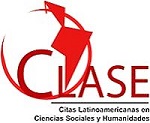Evolução do conceito e suas principais consequências
DOI:
https://doi.org/10.33571/teuken.v11n17a9Palavras-chave:
tecnoestresse, consequências, biblioshinyResumo
O uso das tecnologias da informação e comunicação pode criar condições exigentes e ter o potencial de criar estresse técnico nos trabalhadores. O tecnoestresse começou a ser estudado desde 1982 e, dada a natureza dinâmica das tecnologias, é importante avaliar a evolução do conceito e suas conseqüências. O objetivo deste trabalho é explorar a estrutura intelectual e social da produção científica sobre tecnoestresse e analisar a evolução do conceito, detectando características que influenciam os níveis de tecnoestresse nos indivíduos. Os resultados indicam que os pesquisadores mais relevantes vêm da área de sistemas de informação, que o conceito evoluiu com o tempo e suas consequências também podem ser vivenciadas por pessoas que não trabalham. Concluímos que os programas de prevenção devem considerar diferenças individuais, organizacionais e tecnológicas.Métricas do artigo
Resumo: 4745 PDF (Español (España)): 2809Métricas PlumX
Referências
Al-Qallaf, C. L. (2006). Librarians and technology in academic and research libraries in Kuwait: Perceptions and effects. LIBRI, 56 (3), 168-179. https//doi.org/10.1515/LIBR.2006.168
Alam, M. A. (2016). Techno-stress and productivity: Survey evidence from the aviation industry. Journal of Air Transport Management, 50, 62-70. https//doi.org/10.1016/j.jairtraman.2015.10.003
Aria, M. & Cuccurullo, C. (2017). Bibliometrix: An R-tool for comprehensive science mapping analysis. Journal of Informetrics, 11 (4), 959-975. https//doi.org/10.1016/j.joi.2017.08.007
Arnetz, B. & Berg, M. (1993). Techno-stress: psychophysiological consequences of poor man-machine interface (891-896). En: Smith, M.J. & Salvendy, G. Human-Computer Interaction, Vol 1: Applications and case studies. Amsterdam: Elsevier Science.
Arnetz, B. B. & Wiholm, C. (1997). Technological stress: Psychophysiological symptoms in modern offices. Journal of Psychosomatic Research, 43 (1), 35-42. https://doi.org/10.1016/S0022-3999(97)00083-4
Ayyagari, R.; Grover, V. & Purvis, R. (2011). Technostress: Technological Antecedents and Implications. MIS Quarterly, 35 (4), 831-858. https://doi.org/10.2307/41409963
Brillart, P. E. (2004). Technostress in the Workplace: Managing Stress in the Electronic Workplace. Journal of American Academy of Business, 5, 302-307.
Brod, C. (1984). Technostress: The human cost of the computer revolution. Reading MA: Addison -Wesley. 242 pp.
Brooks, S. (2015). Does personal social media usage affect efficiency and well-being? Computers in Human Behavior, 46, 26-37. https://doi.org/10.1016/j.chb.2014.12.053
Brynjolfsson, E. & Hitt, L. M. (2000). Beyond Computation: Information Technology, Organizational Transformation and Business Performance. Journal of Economic Perspectives, 14 (4), 23-48. https://doi.org/10.1257/jep.14.4.23
Champion, S. (1987). Managing technostress. TechTrends, 32 (5), 31-32. https://doi.org/10.1007/BF02771138
Chandra, S.; Shirish, A. & Srivastava, S. (2019). Technostress inhibit employee innovation? Examining the linear and curvilinear influence of technostress creators. Communications of the Association for Information Systems, 44 (1), 299-331. https://doi.org/10.17705/1CAIS.04419
Dias-Pocinho, M. & Costa-Garcia, J. (2009). Psychosocial impact of information and communication technologies (ICT): Technostress, physical damage and professional satisfaction. Acta Colombiana de Psicología, 11 (2), 127-139.
Fisher, W. & Wesolkowski, S. (1999). Tempering technostress. IEEE Technology and Society Magazine, 18 (1), 28-42. https://doi.org/10.1109/44.752243.
Fuglseth, A.M. & Sorebo, O. (2014). The effects of technostress within the context of employee use of ICT. Computers in Human Behavior, 40, 161-170. https://doi.org/10.1016/j.chb.2014.07.040
Gallardo, A. & De León, S. (2010). Ambientes colaborativos vs entrés laboral en la era de la información. Gestión y Estrategia, 37 (1), 49–60.
Jena, R.K. (2015). Impact of Technostress on Job Satisfaction: An Empirical Study among Indian Academician. The International Technology Management Review, 5 (3), 117-124.
Jena, R.K. (2015). Technostress in ICT enabled collaborative learning environment: An empirical study among Indian academician. Computers in Human Behavior, 51 (B), 1116-1123. https://doi.org/10.1016/j.chb.2015.03.020
Karr-Wisniewski, P. & LU, Y. (2010). When More is Too Much: Operationalizing Technology Overload and Exploring Its Impact on Knowledge Worker Productivity. Computers in Human Behavior, 26 (5), 1061-1072. https://doi.org/10.1016/j.chb.2010.03.008
Kasuga, N.; Itoh, K.; Oisni, S. & Nagashima, T. (2004). Study on relationship between technostress and antisocial behavior on computers. IEICE Transactions on Information and Systems, E87D (6), 1461-1465.
La Torre, G.; Esposito, A.; Sciarra, I. & Chiappetta, M. (2019). Definition, symptoms and risk of techno-stress: a systematic review. International Archives of Occupational and Environmental Health, 92 (1), 13-35. https://doi.org/10.1007/s00420-018-1352-1
Lee, A. R.; Son, S. M. & Kim, K. K. (2016). Information and communication technology overload and social networking service fatigue: A stress perspective. Computers in Human Behavior, 55, 51-61. https://doi.org/10.1016/j.chb.2015.08.011
Lee, Y. K.; Chan, C. T.; Lin, Y. & Cheng, Z. H. (2014). The Dark side of smartphone usage: Psychological traits, compulsive behavior and technostress. Computers in Human Behavior, 31, 373-383. https://doi.org/10.1016/j.chb.2013.10.047
Lei, C. & Ngai, E. (2014). The Double-Edged Nature of Technostress on Work Performance: A Research Model and Research Agenda. In: M. D. Myers & D. W. Straub (eds.). ICIS: Association for Information Systems.
Leung, L. & Zhang, R. (2017). Mapping ICT use at home and telecommuting practices: A perspective from work/family border theory. Telematics and Informatics, 34 (1), 385-396. https://doi.org/ 10.1016/j.tele.2016.06.001
Maier, C.; Laumer, S.; Eckhardt, A. & Weitzel, T. (2015). Giving too much social support: Social overload on social networking sites. European Journal of Information Systems, 24 (5), 447-464. https://doi.org/ 10.1057/ejis.2014.3
Maier, C.; Laumer, S.; Weinert, C. & Weitzel, T. (2015). The effects of technostress and switching stress on discontinued use of social networking services: A Study of Facebook use. Information Systems Journal, 25 (3), 275-308. https://doi.org/10.1111/isj.12068
Nimrod, G. (2018). Technostress: measuring a new threat to well-being in later life. Aging and Mental Health, 22 (8), 1080-1087. https://doi.org/10.1080/13607863.2017.1334037
Ragu-Nathan, TS, Tarafdar, M.; Ragu-Nathan, B. & TU, Q. (2008). The consequences of Technostress for end users in organizations: Conceptual Development and Empirical Validation. Information Systems Research, 19 (4), 417-433. https://doi.org/10.1287/isre.1070.0165
Riedl, R.; Kindermann, H.; Auinger, A. & Javor, A. (2012). Technostress from a neurobiological perspective: System breakdown increases the stress hormone cortisol in computer users. Business and Information Systems Engineering, 4 (2), 61–69. https://doi.org/10.1007/s12599-012-0207-7
Riedl, R. (2013). On the Biology of Technostress: Literature Review and Research Agenda. Data Base for Advances in Information Systems, 44 (1), 18-55. https://doi.org/10.1145/2436239.2436242
Saganuwan, M. U.; Ismail, K. W. & Ahmad, N. U. (2015). Conceptual framework: AIS technostress and its effect on professionals’ job outcomes. Asian Social Science. Canadian Center of Science and Education, 11 (5), 97-107. https://doi.org/10.5539/ass.v11n5p97
Sahin, Y. L. & Coklar, A. N. (2009). Social networking users’ views on technology and the determination of technostress levels. Procedia Social and Behavioral Sciences, 1, 1437–1442. https://doi.org/10.1016/j.sbspro.2009.01.253
Salanova, M. (2003). Trabajando con tecnologías y afrontando el tecnoestrés: el rol de las creencias de eficacia. Revista de Psicología del Trabajo y de las Organizaciones, 19 (3), 225–246.
Salanova, M.; Llorens, S. & Cifre, Eva. (2007). NTP 730: Tecnoestrés: concepto, medida e intervención psicosocial. https://www.insst.es/InshtWeb/Contenidos/Documentacion/FichasTecnicas/NTP/Ficheros/701a750/ntp_730.pdf
Salanova, M.; Llorens, S. & Cifre, E. (2013). The dark side of technologies: Technostress among users of information and communication technologies. International Journal of Psychology, 48 (3), 422–436. https://doi.org/10.1080/00207594.2012.680460
Salazar-Concha, C. E.; Parra, R.; Olivera, L. & Ramírez-Correa, P. (2020). Inefficiency beliefs, computational fatigue, and computational anxiety: An exploratory study in office secretaries. RISTI, Revista Ibérica de Sistemas e Tecnologias de Informacao, 2020 (E28), 258–271. http://www.risti.xyz/issues/ristie28.pdf
Salazar Concha, C. E. (2007). El teletrabajo como aporte a la inserción laboral de personas con discapacidad en Chile: una gran carretera virtual por recorrer. Ciencia & Trabajo, 9 (25), 89–98.
Salazar Concha, C. E. (2019). El tecnoestrés y su efecto sobre la productividad de los trabajadores chilenos: Un estudio psicométrico y predictivo (Tesis doctoral). Universitat Oberta de Catalunya, Barcelona, España.
Sellberg, C. & Susi, T. (2014). Technostress in the office: A distributed cognition perspective on human-technology interaction. Cognition, Technology and Work, 16 (2), 187–201. https://doi.org/10.1007/s10111-013-0256-9
Shu, Q.; TU, Q. & Wang, K. (2011). The Impact of Computer Self-Efficacy and Technology Dependence on Computer-Related Technostress: A Social Cognitive Theory Perspective. International Journal of Human-Computer Interaction, 27 (10), 923–939. https://doi.org/10.1080/10447318.2011.555313
Srivastava, S.; Chandra, S. & Shirish, A. (2015). Technostress creators and job outcomes: theorising the moderating influence of personality traits. Information Systems Journal, 25 (4), 355–401. https://doi.org/10.1111/isj.12067
Suh, A. & Lee, J. (2017). Understanding teleworkers’ technostress and its influence on job satisfaction. Internet Research, 27 (1), 140–159. https://doi.org/10.1108/IntR-06-2015-0181
Tacy, J. (2016). Technostress: A concept analysis. Online Journal of Nursing Informatics, 20 (2).
Tams, S.; Hill, K.; De Guinea, A.; Thatcher, J. & Grover, V. (2014). NeuroIS-Alternative or Complement to Existing Methods? Illustrating the Holistic Effects of Neuroscience and Self-Reported Data in the Context of Technostress Research. Journal of the Association for Information Systems, 15 (10), 723–753.
Tarafdar, M.; TU, Q.; Ragu-Nathan, B. & Ragu-Nathan, T.S. (2007). The impact of technostress on role stress and productivity. Journal of Management Information Systems, 24 (1), 301–328. https://doi.org/10.2753/MIS0742-1222240109.
Tarafdar, M.; TU, Q.; Ragu-Nathan, T.S. & Ragu-Nathan, B. (2011). Crossing of the Dark Side: Examining Creators, Outcomes, and Inhibitors of Technostress. Communications of the ACM, 54 (9), 113–120. https://doi.org/10.1145/1995376.1995403
Tarafdar, M.; D’arcy, J.; Turel, O. & Gupta, A. (2015). The Dark Side of Information Technology. MIT Sloan Management Review, 56 (2), 61–70.
Tarafdar, M.; Pullins, E.B. & Ragu-Nathan, T.S. (2015). Technostress: Negative effect on performance and possible mitigations. Information Systems Journal, 25 (2), 103–132. https://doi.org/10.1111/isj.12042
Tarafdar, M.; Cooper, C. & Stich, J. F. (2019). The technostress trifecta - techno eustress, techno distress and design: Theoretical directions and an agenda for research. Information Systems Journal, 29 (1), 6–42. https://doi.org/10.1111/isj.12169
Tarafdar, M.; Pullins, E. & Ragu-Nathan, T. S. (2011). Examining impacts of technostress on the professional salesperson’s behavioral performance. Journal of Personal Selling & Sales Management, 34 (1), 51-69. https://doi.org/10.1080/08853134.2013.870184
Tarafdar, M.; TU, Q. & Ragu-Nathan, T.S. (2010). Impact of technostress on end-user satisfaction and performance. Journal of Management Information Systems, 27 (3), 303–334. https://doi.org/10.2753/MIS0742-1222270311
TU, Q.; Wang, K. & Shu, Q. (2005). Computer-related technostress in China. Communications of the ACM, 48 (4), 77–81. https://doi.org/10.1145/1053291.1053323
Van-Eck, N. & Waltman, L. (2010). Software survey: VOSviewer, a computer program for bibliometric mapping. Scientometrics, 84, 523-538. https://doi.org/10.1007/s11192-009-0146-3
Wang, K.; Shu, Q. & TU, Q. (2008). Technostress under different organizational environments: An empirical investigation. Computers in Human Behavior, 24 (6), 3002–3013. https://doi.org/10.1016/j.chb.2008.05.007
Weil, M. & Rosen, L. (1997). Technostress: Coping with Technology Work Home Play, 1a ed. New York: Wiley, 239 pp.
Yun, H.; Kettinger, W. & Lee, C. (2012). A New Open Door: The Smartphone’s Impact on Work-to-Life Conflict, Stress, and Resistance. International Journal of Electronic Commerce, 16 (4), 121–151. https://doi.org/10.2753/JEC1086-4415160405
Downloads
Publicado
Como Citar
Edição
Seção
Licença
Copyright (c) 2020 Cristian Salazar-Concha, Pilar Ficapal-Cusí, Joan Boada-Grau

Este trabalho está licenciado sob uma licença Creative Commons Attribution-NonCommercial-ShareAlike 4.0 International License.


























